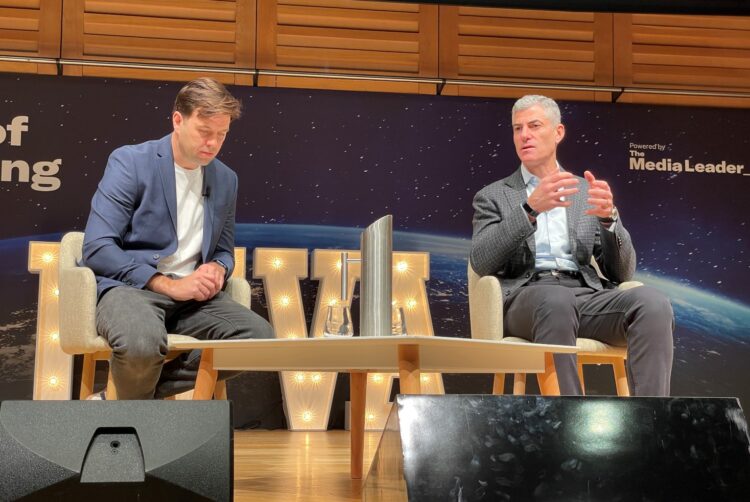We’re a friend to the TV market, insists Amazon ad sales VP

The Future of TV Advertising Global 2024
“I think the room is trying to figure out: are you a friend or a foe? So which one is it?”
Amazon Ads’ vice-president of global ad sales, Alan Moss, was asked directly whether Amazon, which this year entered the ad-supported streaming market, was willing to work with TV industry bodies and joint industry currencies (JICs) to provide transparency.
“We’re a friend,” replied Moss. “Look, everyone’s got more content choices than you ever had before. Great viewing options. I think the marketplace wins when you have more options.”
Moss was speaking in an interview with Adwanted Events director Justin Lebbon at The Future of TV Advertising Global 2024 on Wednesday.
He explained that Amazon has been trying to “thread a needle” between providing familiar measurement with third parties in the countries where it has launched its ads tier, while at the same time embracing “what makes Amazon unique — and that’s innovation”.
“As a digital streaming service, we have a lot of first-party insights we can bring, some unique measurement that we can also offer and capabilities that are really different, like shoppable ads”, said Moss. “We’ve also really wanted to lean in to the capabilities of digital and hopefully shape a bit of what TV is going to look like in the future.”
But, he added, transparency is hugely important — “We know there’s plenty of advertisers that don’t want us grading our own homework” — and the company has been open to working with JICs and industry bodies.
In the UK, Amazon joined TV JIC Barb and TV marketing body Thinkbox in February.
Bringing new advertisers to market
It has been nearly a year since Amazon Prime Video launched its default ad tier and Moss said currently it counts 200m monthly active users globally, including 115m in the US, 19m in the UK and 12m in Canada.
Amazon’s overall ad services grew 19% to $14.33bn in Q3, while subscription revenue grew 11% to $11.28bn.
Reflecting on the ad tier’s early success, Moss said he was “pleased to say it’s gone really well”, adding that it “hit our expectations” — although “we’re always unsatisfied at Amazon and we always want to do better on behalf of our advertisers”.
That includes new ones, be they new-to-TV brands or new-to-Amazon advertisers. Moss said live sports has been a major draw for these brands and Amazon wants to “democratise” TV by appealing to the long tail.
For example, he revealed 40% of advertisers during Prime Video’s Black Friday NFL game last month were new to Amazon.
American football has been a major boon to Prime Video. Apart from the Black Friday game, Amazon hosts weekly exclusive coverage of Thursday Night Football, which Moss said has helped to bring a younger audience to the game.
‘Considerable upside’: Amazon ad revenue tops growth among tech giants despite slowdown
Moving back up the funnel
The retail giant has also taken a “nimble” approach to client relations around these games to allow for eleventh-hour ad buys. Moss cited instances where Amazon “shot the ad the day of the game” for a client.
Moss championed Prime Video as helping to “bring full-funnel marketing to life” for advertisers by offering top-of-funnel opportunities alongside premium TV shows and lower-funnel opportunities driven by Amazon’s retail dominance and the data that comes with it.
That said, while Amazon can offer performance-based options, marketing chiefs at major brands have started to move back “up the funnel” after a Covid era in which performance advertising became increasingly popular, he noted.
“We’re finding advertisers starting to speak that [brand] language as well,” Moss said. “You can only get so far as a business mopping up excess demand. At some point, brands need to start to create demand.”
Keeping ad loads low
Moss said it “mattered that we had immediate scale” given Prime Video’s decision to opt all users into an ad tier or pay more to avoid ads.
Furthermore, a key point of difference in Amazon’s favour was how few ads run on the streaming platform, he suggested.
“We want to make sure we have a meaningfully lower ad load than other services,” Moss said. “We’ve been very consistent in wanting to have a great customer experience.
“We think if you show relevant ads that are informative and helpful about products and services that you’re interested in, customers will stick with you.”
Monetising Prime Video also drives revenue growth that can be reinvested into content development.
Moss said Amazon will continue to invest in “diverse content that appeals to a really wide audience”, including in sports, films and TV programmes, such as game shows and reality shows.




